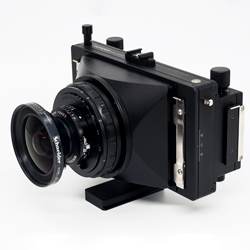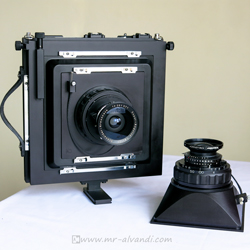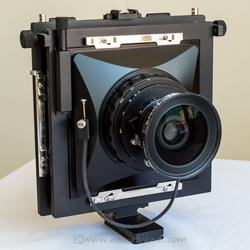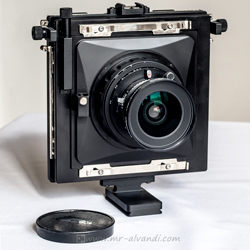Using black and white films to make monochrome slides
Introduction
Nowadays black and white films have a great ability to create high-quality images. Negative images created by them, to be converted by a variety of paper and scanners to positive images. But for some special purpose, we need to black and white transparency (slide) images. One of these cases is use of black and white slide in projectors. In this case can be prepared black and white slide from negatives.
Agfa company has produced a special black and white slide film named Scala. Which is quite remarkable. But if this film is not available, the proposed method can be used.
The following method is a guide for making a slide of black and white negatives. With this method, we can produce a copy of the original negatives or slides. (Duplicating)
Principles
The building of a slide film, almost the same as that used in normal negative film. In this web page, how to develop black and white film, I explained the fully building negatives.
At first silver halides exposed in the film, will develop and converted into silver metal. Then the silver metal is removed from the film by the bleach solution. Therefore film will be devoid of black silver. Then again exposed the film. And now for the second time will be affected by the developing solution and then fixing. And thus can be achieved by using the conventional negative film, reversal image (black and white slide).

What kind of film is suitable for making black and white slides?
Generally, this process is suitable for negatives which they have inherently high contrast. So films with medium and low sensitivity, are appropriate. Of course by change process can be manipulated in the final contrast image.
I have used this process for Ilford FP4 Plus and Fortepan 200 6x9 sheet film. You can apply this process for the other negatives, including Kodak Tmax 100, Ilford Delta 100 and Ilford PanF. Ilford FP4 and Kodak Tmax 100, create a slide by normal contrast. But Ilford PanF, will create a slide with higher contrast and brighter, which is more suitable for copying work.
Not recommended for ISO 400 negatives. They have low contrast.
The exposure conditions for making slide of black and white negatives
When exposing negative films for printing on paper, exposure is not that critical parameter. Because any variation in negative density can usually be compensated for in printing by a variety of papers.
But when a negative be converted to slides during a process, exposure must be accurate to achieve the appropriate slide in terms of clarity and quality. Because after finishing work, it will not be compensated in any way.
In general, it is better adjust the sensitivity of the film previously by trial and error for this purpose. Then to be used for more serious work.
Chemicals required to processing the slide, from black and white negatives
Reversal processing from black and white negatives, includes 6 main step:
1– First developer
At this step, the exposed negative, will be affected by the developing solution. Therefore silver halides in the film, be converted to black metallic silver. The first developer solution has a major impact on the final result. This solution should be powerful, to affect on the film completely. Adding Potassium thiocyanate, Ammonia and or Sodium thiosulphate is required, to reduce the minimum and maximum density on the image (contrast).
Time and temperature of the developing solution is very important and very influential in the final result. The developing time can be changed according to the sensitivity of the film. But the temperature of developing solution must be kept constant. The following formula developing time has been set 10 minutes. This time as a basis, and may change depending on the type and sensitivity of the film. It should be noted, the higher developing time, create brighter slide and vice versa.
I've used the following formula to concentrated, you may according to the experience, dilute it up (1+1).
| 1 | Water 50° C | 750 ml |
| 2 | Metol | 2 gr |
| 3 | Sodium sulphite anhydrous | 100 gr |
| 4 | Hydroquinone | 5 gr |
| 5 | Sodium carbonate monohydrate | 60 gr |
| 6 | Sodium thiosulfate pentahydrate (Hypo) | 16 gr |
| 7 | Potassium bromide | 4 gr |
| 8 | Water | Up to 1000 ml |
| Developing time 10 minutes at 20 °C for concentrated | ||
If you're using Kodak D-76 solution for developing negatives, you can solve in 250 ml D-76 concentrated, per roll, the following materials.
| 1 | Sodium carbonate monohydrate | 15 gr |
| 2 | Sodium thiosulfate pentahydrate (Hypo) | 4 gr |
| 3 | Potassium bromide | 1 gr |
2– Bleach
Bleach solution removes all silver halide from the negative, which previously had become by first developer solution to metallic silver. This solution is highly acidic and contains Potassium dichromate. The duration of this will be between 3 to 6 minutes. This time according to the type and sensitivity of the film may change.
Bleach solution formula is provided in the following table:
| 1 | Potassium dichromate | 9.5 gr |
| 2 | Sulfuric acid 98% | 12 gr |
| 3 | Water | Up to 1000 ml |
Bleach solution preparation:
Add Potassium dichromate in 500 ml of water and dissolve it. Then slowly and stirring the solution at the same time, add sulfuric acid. Then add water up to 1000 ml.
Very Important Note: Do not add water to Sulfuric acid. You remember should be added Sulfuric acid into the water.
3– Clearing solution
Clearing solution removes any yellow staining that was created by the bleach solution on the surface of the film. This solution eliminates traces amounts of powerful bleach solution of the film and cause it to be clear. Clearing solution duration time is 1 to 2 minutes with stirring.
Clearing solution formula is provided in the following table:
| 1 | Sodium sulphite anhydrous | 50 gr |
| 2 | Water | Up to 1000 ml |
4– Second Exposure
After removing the metallic silver from negative, the next step, should be re-exposure to the rest of the silver halide in the surface film. Name of this step is repeated exposure (second exposure).
In the previous steps, negative photographed, was influenced by the developing solution, and then in the process of bleach, removed the image. Now, the remaining silver halide by re-exposure, must create final positive image.
The second exposure is very important. The second exposure condition is as follows:
30 to 60 seconds, a distance of 45 cm with a 100 watt tungsten lamp or 30 cm with fluorescent tube.
Over this time may produce fog in the film. Do not use of sunlight at this step.
5– Secondary developing step
At this step, all silver halide exposed in step 4 should be fully affected by the secondary developer solution, so we obtain final positive image. One of the best developer solutions for this step is Kodak D-72 or Dektol with a ratio of 1: 2 and developer time of 3 minutes. If you use another formula for this step, may change the developing time.
Kodak D-72 or Dektol formula is provided in the following table:
| 1 | Water 50° C | 500 ml |
| 2 | Metol | 3.1 gr |
| 3 | Sodium sulphite anhydrous | 45 gr |
| 4 | Hydroquinone | 12 gr |
| 5 | Sodium carbonate monohydrate | 67.5 gr |
| 6 | Potassium bromide | 1.9 gr |
| 7 | Water | Up to 1000 ml |
6– Stop and fixing steps
These steps are exactly according with black and white negatives stop and fixing steps. Stop solution, interrupt the process of the Second developer, and the fixing solution will remove all additional silver halides remaining in the film surface.
Stop time is between 15 to 30 seconds and the fixing time 5 minutes. Stop and fixing formula are provided in the following tables:
| 1 | Acetic acid 28% | 30 ml |
| 2 | Water | 970 ml |
| 1 | Food grade Acetic acid 5% | 150 gr |
| 2 | Water | 970 ml |
| 1 | Water 50° C | 750 ml |
| 2 | Sodium thiosulfate (hypo) | 240 gr |
| 3 | Ammonium chloride | 25 gr |
| 4 | Sodium bisulfite | 20 gr |
| 5 | Water | Up to 1000 ml |
Instructions developing process slides of black and white negative films
The developing process slides of black and white films, is included 7 baths in 14 steps. These solutions are the first developer, bleach, clearing solution, the second developer, stop, fixer and photo–flo. The following table shows the various steps of developing process slide of black and white films. All solutions temperature are 20 ± 1 °C.
| Step | Time | Storage Conditions | Working conditions | Terms of stirring |
| Pre-Washing | 3 times, each time 15 seconds | Drain to wastewater | Total darkness | Shake continuously |
| First Developer | 10 minutes (depending on the sensitivity of the film may change) | Drain to wastewater | Total darkness | The first 45 seconds continuously, then every 30 seconds, 5 seconds shake |
| Washing | 3 times, each time 15 seconds | Drain to wastewater | Total darkness | Shake continuously |
| Bleach | 3-6 minutes | Drain to wastewater | Total darkness | Shake continuously |
| Washing | 3 times, each time 15 seconds | Drain to wastewater | Total darkness | Shake continuously |
| Clearing solution | 2 minutes | Re-usable | Total darkness | Shake continuously |
| Washing | 3 times, each time 15 seconds | Drain to wastewater | Total darkness | Shake continuously |
| Second Exposure | 30 to 60 seconds. | 100 watt tungsten lamp at a distance of 45 cm - fluorescent lamp 30 cm | ||
| Second developer | 3-6 minutes (depending on the sensitivity of the film may change) | Drain to wastewater | Total darkness | The first 45 seconds continuously, then every 30 seconds, 5 seconds shake |
| Washing | 3 times, each time 15 seconds | Drain to wastewater | Total darkness | Shake continuously |
| Stop | 15 to 30 seconds. | Re-usable | Total darkness | Shake continuously |
| Washing | 3 times, each time 15 seconds | Drain to wastewater | Total darkness | Shake continuously |
| Fix | 5-6 minutes | Re-usable | Total darkness | Shake continuously |
| Final washing | 10 minutes with flowing water | Drain to wastewater | Lighting | Shake continuously |
| Photo-flo | 15-20 sec | Drain to wastewater | Lighting | Shake continuously |
Start the development process of this way:
1– In the total darkness, you load the film, in the special reel tank, and close the tank door. If using sheet film, you use the developing tray in the darkness, or use the special tank for it.
2– Please check the temperature to be 20 degrees Celsius.
3– Open the small door the tank, and the pre-washing done, and to discharge the water completely.
4– Add the first developer solution, and close the tank door. Simultaneously turn on the timer. Initially, drag upwards the bottom of the tank a few times, until the air bubbles are separated from the surface of the film. In the first 45 seconds continuously, upside down the tank, and then every 30 seconds for 5 seconds, it will upside down. During the 30 seconds, the tank to drop a resident. Put immobilized the tank within 30 seconds. (Do not shake the tank on a regular basis at this stage, it can cause negative of grainy)
5– Do the washing step and add bleach to the tank. Shake the tank regularly. Then pour it on the wastewater.
6– Do the washing step and add clearing solution to the tank. Shake the tank regularly. Then pour it into bottle.
7– Do the washing step and then open the tank door. Remove the film from the reel, and exposed of the two sides. As follows:
30 to 60 seconds, a distance of 45 cm with a 100 watt tungsten lamp or 30 cm with fluorescent tube.
8– In total darkness, cautiously load the film again on the reel, and put into tanks. Try not to touch the emulsion surface.
9– Add the second developer solution, and close the tank door. Simultaneously turn on the timer. Initially, drag upwards the bottom of the tank a few times, until the air bubbles are separated from the surface of the film. In the first 45 seconds continuously, upside down the tank, and then every 30 seconds for 5 seconds, it will upside down. During the 30 seconds, the tank to drop a resident. Put immobilized the tank within 30 seconds.
10– Do the stop and fixation, in accordance with the instructions in the negatives developing.
11– Open the tank door and wash with running water for 10 minutes as final.
12– Whatever the final rinse longer and be more accurate, slide life will be longer.
13– Immerse and then remove the reel to photo–flo solution.
14– Remove the film from reel, and attached to both sides film Clips. Slowly, clean now water on the film surface by soft sponge, and hung to dry in a place free from dust.




Copying of negatives and slides (Preparation Duplicate)
Another application of this process, is the copying (duplicating) of a negative and producing other negative, or copying of a slide and producing other slides. For this purpose, there are two methods:
1– Contact method:
In this method placed an original negatives or slides film on another raw negatives film, and the use of a simple piece of glass to flattening them. Then exposed the obtained sandwich, from the glass.
1– Photography method:
The second method is by using camera and with the help of a macro lens and special bellow. Image quality, in this method would be very suitable.
So after shooting from the original film, the image obtained after the first developer will be positive. And after using the bleach solution and second developer, negative image can be obtained.
For copying (duplicating) the black and white slide film, will be used from the same way exactly.
Several advised to improve the quality of black and white slide:
1– Try to use a standard procedure to your work.
2– Try to use from the medium sensitivity films.
3– The first exposure determines the fate of the final image. Exposed to film carefully.
4– The first developer is very effective to the density and quality of the final image. Determine, the developing time experimentally.
5– Try to keep the temperature at 20 °C in all steps of the process.
6– After the second exposure not touch the surface of the film. The emulsion is very sensitive and vulnerable.
7– Make sure that in the second exposure, exposed both sides of the film. If the exposure be done less than needed, the final image will be darker.
8– Always use fresh solution.
9– The amount of sodium thiosulfate in the first developer solution, has very influence on the average density of the image. Reducing it, increased image contrast.
10– I've used Kodak D-76 for the first and second developer, but I think the final slide is a little foggy.
11– The various types of developer and bleach solution recommended for these processes. It may be different for various types of films. I have used this process for Ilford FP4 Plus and Fortepan 200 6x9 sheet film.
Several important safety recommendations:
1– Do the safety conditions. Use of latex gloves for this process.
2– Sodium dichromate is carcinogenic. Use caution when working with this material.
3– Concentrated Sulfuric acid is very corrosive. Avoid contact with skin and eyes severely.
4– Always add Sulfuric acid in small amounts on the water. Do not add water to the acid.
5– In case of contact Sulfuric acid with skin, immediately wash the skin with a solution containing Sodium bicarbonate 10%.
6– Bleach solution is acidic and corrosive severely avoid contact with skin.
7– Prepare bleach solution in a well-ventilated space.








